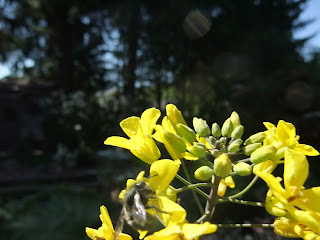 |
| Bees will forage and pollinate any flower that has food for them. Plants that produce lots of nectar and pollen are preferred over others. This is a cabbage flower. |
If my increase in mason bees over four years is a normal increase in numbers, I should have bees by the billions. I don't.
We know that if parasitism and predation gets away from you, numbers of cocoons produced can drop dramatically.
But there are other factors.
Food availability is a non- brainer. But it is difficult to assess if the quantity and quality is out there for our mason bees. Seeing flowers is one thing, but knowing the quality of the pollen is another. We usually assume lots of flowers means lots of food.
All these factors are important, but nothing works if the weather does not cooperate.
So making a structure that keeps the bees warm and out of the rain and wind, makes a lot of sense. It is not only important to keep the nest warm for the adults, but for the developing young as well.
The open wooden structures (as in picture above) were unwieldy and protection from the weather was minimal altough sufficient if the weather was sunny!
The Gazebo for mason bees was born. More next time.

Last summer we had outstanding bee increase and filled box after box for friends to start their own. We noticed that after the fruit tree bloom and then the grape and garden flowers that bee activity just disappeared, meaning a few filled holes hatched out but only one or two more holes were filled. My theory is that the food sources dried up. Since we read that you can't move the boxes before November, if you don't have a diverse food source locally, reproduction will be limited.
ReplyDelete